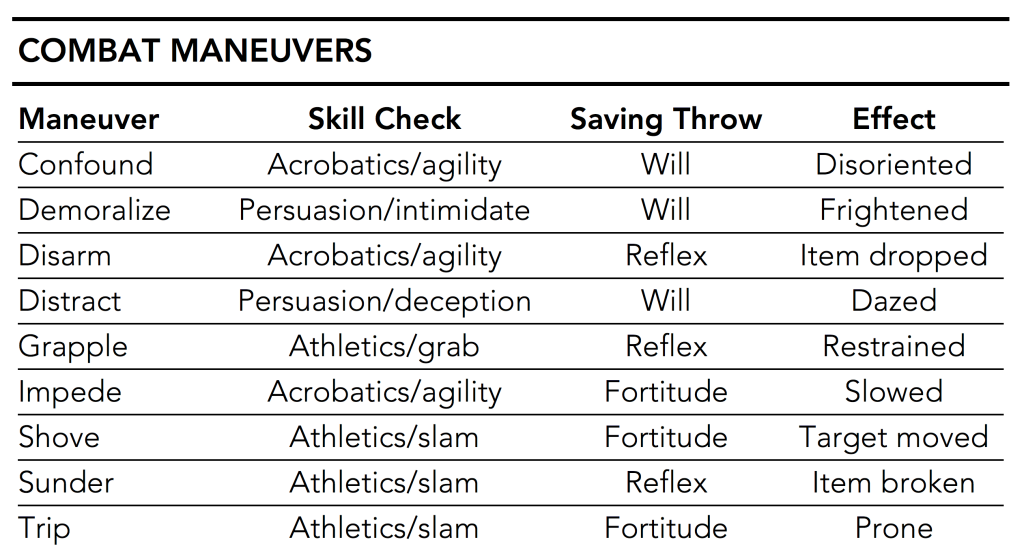A confession: I really love combat in D&D and other RPGs. Like, a lot. My favorite class has always been the fighter. I love the story that plays out through a character’s choice of weapons and armor. I live for the vicarious feeling of reliving every heroic tale I ever read as a kid by having that fighter character stand against evil backed by nothing but strength and steel.
At the same time, though, I love the many and varied ways that D&D can play out without combat. In the home games I run, we can routinely go three full sessions back to back engaging in nothing but roleplaying, investigation, and skill checks. And when a combat scenario looms in those home games, I get full satisfaction out of the players engaging in elaborate plans to bypass that combat, or engaging in shenanigans that get two different enemies taking each other out while the party just hangs back and watches.
Combat is fun. But because I’ve always found avoiding combat just as much fun, I knew right from the beginning that I wanted CORE20 to support that style of play. Because CORE20 is built on the chassis of the Creative Commons D&D SRD, all the ways that characters can avoid violence in the game carry over, of course. If you also enjoy that style of play, you’ll find that the work-around-or-sabotage-the-bad-guys style of play actually works better in CORE20 than it does in stock D&D because CORE20 avoids the pass/fail tedium of skill checks that can make planning and subterfuge in the game sometimes feel undramatic.
The First Rule of D&D Club
In the end, though, d20 fantasy always inevitably wants to move toward skirmish combat, courtesy of D&D’s war game DNA. So I started thinking at some point about how one might try to create options in d20 combat that were more narratively interesting than just battering your enemies into submission with weapon attacks. And in so doing, I kept coming back to the question: What if not fighting the way you’re always expected to fight in a d20 game could be as much fun as fighting?
Combat maneuvers in CORE20 are the answer I came up with to that question — a set of rules that cover grappling, tripping, disarming, and a bunch of other combat options for characters who want to do more than just beat their enemies down each and every time. Combat maneuvers were actually one of the last subsystems I wrote for the game, back in 2022 for version 6 of the alpha playtest. It’s a pretty straightforward system, combining two familiar mechanics — skill checks on the attacker’s side and saving throws on the defender’s side — to do things a bit differently than d20 fantasy has traditionally done.

You can see the breakdown of available maneuvers in the table above, and can read all the details starting on page 259 of the Playtest Player’s Guide. But the general idea is that when your character gets into a fight, CORE20 provides ways that you can finish or get out of that fight that don’t just involve treating foes as bags of hit points.
Advanced Conflict Resolution
When I finished the initial draft of the combat maneuvers system, I put it to the test with a short urban campaign that had an unusual setup for character creation — no weapon feats. Characters could take Weapon Focus once, gaining a modest +1 bonus to attacks, if a player felt naked running a hero without a sword, but that was it. For everything else, the players had to think about ways they might get out of fights — because the campaign was absolutely going to involve combat scenarios — other than responding to violence with violence. And it was a great time.
(As an aside: One of the touchstones I made use of in that campaign when talking to the players about archetypal characters who constantly get into scrapes but don’t start punching their way out of those scrapes by default were the 1970s detective shows of my childhood. Those shows featured tough, hard-edged cops and private eyes caught up in the sorts of stories you’d expect — but those heroes were limited in how much violence they could use to respond to threats by the network standards of the day. Arguably the best of those archetypes (and my own personal favorite) was Jim Rockford from The Rockford Files, who famously kept his pistol hidden in a cookie jar, and whose go-to move was to punch a bad guy as a distraction before running like hell.)
Combat maneuvers weren’t the only thing that made the campaign memorable. One character made use of spelltouched illusion ability to keep foes guessing what was real, and the game offers plenty of nondamaging spellcasting options for characters who want to avoid bloodshed. But that campaign and the campaigns that followed have all shown off how much more interesting combat can be with enemies — and the characters from time to time — upended, unable to see, momentarily unnerved, running after their weapons when they go flying across the battlefield, and much more.
Most importantly, unlike the options in traditional d20 games for grappling, shoving, and so forth, CORE20 lets you build characters who are really, really good at avoiding lethal combat in favor of dealing with combat threats in other ways. Because you get to decide exactly which things your character is good at and which things they never bothered to learn, alternative combat options can be your character’s primary forte — not just a secondary add-on to their default ability to hack and slash.
• • •
Questions about combat maneuvers or anything else in CORE20? Join us on the CORE20 Discord server and ask away!
(Art by Gary Dupuis)

